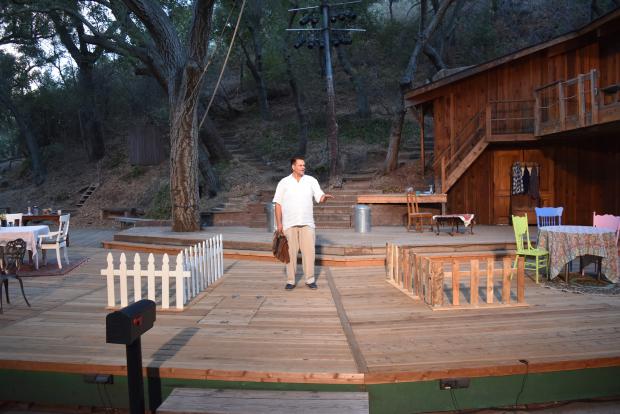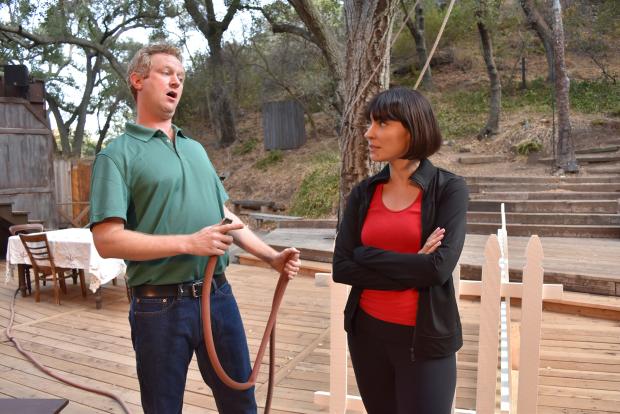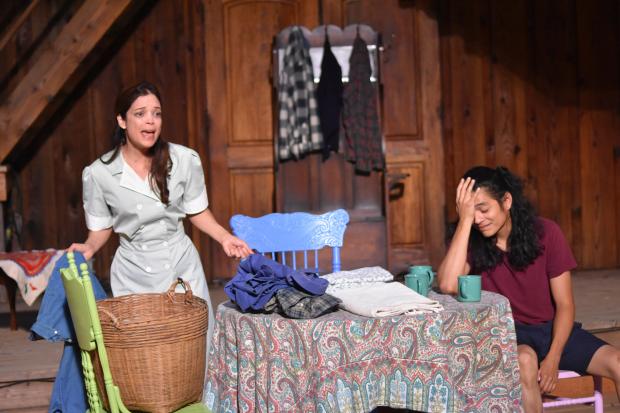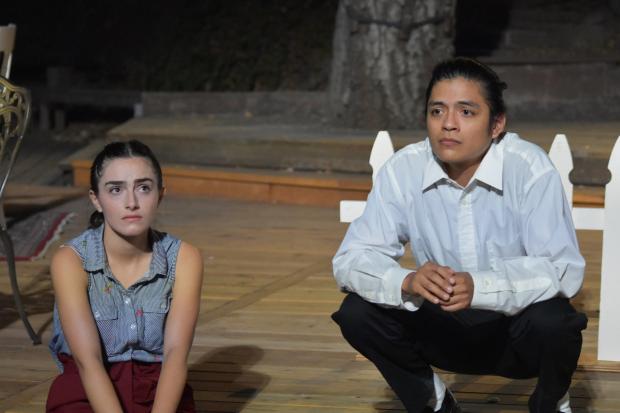Advertisement
In The Last, Best Small Town playwright John Guerra has adapted Thornton Wilder’s 1938 Pulitzer Prize-winning drama Our Town, resetting the turn-of-the-last-century Grover’s Corner, New Hampshire at turn-of-the-21st-century Fillmore, California, which is located a bit north of Six Flags Magic Mountain, in Ventura County. In doing so, Guerra has injected contemporary ethnic, as well as economic and wartime concerns into Wilder’s Americana classic, which – along with gems like Romeo and Juliet – is one of those perennial favorites performed by junior high and high school theater departments across the USA.
In Best two families live side-by-side in middle class homes. As the Playwright (Leandro Cano, who has multiple roles) – instead of Wilder’s Stage Manager – this omniscient character sets the stage and introduces us to the dramatis personae. The Caucasian Miller family includes Hank Williams (Christopher Wallinger, who looks like he has stepped out of sitcom central casting), editor of Fillmore’s daily newspaper, and Willow (Christine Breihan), a perky housewife devoted to mothering and fitness classes, in order to (as she says) keep her ass firm for her husband’s admiration. The Millers have two children: Maya (Jordan Tyler Kessler), a stellar student, and her older unseen brother Marcus, who remains an offstage presence throughout the two-act play and comes the closest to perpetuating the otherworldly ambiance of Wilder’s original work.
The Gonzalez family inhabits the neighboring Mexican-American household, which appears to be more blue collar than the Millers are. Benny (Richard Azurdia) rises early to catch a bus to ride to his job at an auto dealership in Valencia, while Hank takes his time to meticulously water his lawn (WGTB missed an opportunity to actually have water sprayed from Miller’s hose, which would have been the first time this reviewer had ever seen this effect done onstage – oh well!). Benny’s hard working wife Della (Katia Gomez, who is in the soon-to-drop Mona Lisa and the Blood Moon with Kate Hudson) cleans rooms at a nearby Best Western, and also some local homes, including the Millers. In terms of the play’s dynamics, this is significant as it suggests a racially subservient role and position in the pecking order vis-à-vis her white neighbors.
Chuy, Benny’s father who crossed the border decades ago and currently drinks too much and is perpetually short of cash, is played by Miguel Pérez, whose screen credits include Ocean’s Eleven and Million Dollar Baby. Della and Benny’s son Elliot (Kelvin Morales) is, like Marcus, about to graduate from Fillmore’s high school. But unlike his next-door neighbor, who plans to join the Marines, Elliot is the class valedictorian. But as his speech at the graduation ceremony on the night Best opens reveals, his proletarian parents’ expectations for their hijo to become the first member of the family to get a college education and go on to have a white collar career that Della and Benny have sacrificed so much for weighs heavily on the teenager.
In a telling scene, Della exposes how image and status conscious she is when she insists that her casually clad son get dressed up in chinos and a polo shirt just to drop her off where she works, in order to impress her co-workers (who, of course, couldn’t care less anyway). The fact that she is so prestige driven is belied by the fact that Elliot has extremely long hair, and I feel certain that any parent who was so anxious about a son’s appearance would likewise comment on his grooming, and likely insist that he get a haircut. So this was a bit unrealistic and inconsistent.
In any case, as the play proceeds, Elliot and Maya become romantically involved, which is complicated by their different ethnic backgrounds. But to Guerra’s credit, the drama goes beneath the surface and shows the reality that white people, too, struggle and suffer in capitalist America. Marcus is deployed overseas in Afghanistan, which makes Best quite timely. And not only has the Bush regime ensnared the USA in never-ending, unnecessary wars, but it has also wrecked the economy with the 2007/2008 Wall Street meltdown, which triggers mortgage and related crises. And the Millers’ white skins do not exempt them from the ensuing hardships.
Guerra’s sharp eye also dramatizes the shifting landscape of journalism, as readership and advertising move more and more from print to the digital realm. Of course, this greatly impacts upon Hank Williams, who is no Ted Williams, one of baseball’s greatest sluggers; but Best’s Hank is not hitting any homeruns, as his daily newspaper downsizes into a weekly, slashing his paycheck.
In press notes the dramatist, who is Mexican-American/Caucasian, says: “The play is also a way for me to reckon with my own identity. A lot of the issues that Maya and Elliot struggle with were my own as I came of age, and the conversations about race they are forced to confront are ones that, as someone who is mixed, are constantly going on within myself.” Being bi-racial seems to empower Guerra to be able to envision all sides of an issue.
Directed by Ellen Geer, Best is well-acted by an ensemble cast. Unlike many other productions at Will Geer’s Theatricum Botanicum, Best’s mise-en-scene generally does not encompass all of the amphitheater’s ample space. This is more like watching live theater with a proscenium stage, albeit rather gloriously under the stars.
I was especially interested in Best because, in addition to its dramatizing issues of race and class in an intelligent and entertaining way, I actually am personally familiar with Fillmore. Luis Reyes, my co-author of three film histories, including The Hawaii Movie and Television Book, used to live in Fillmore around the time Guerra’s story is set, and I used to visit this slice of smalltown USA then.
Best is not the Theatricum’s first Wilder-related production – in 2019 I enjoyed WGTB’s rendition of the WWII era The Skin of Our Teeth, which was also helmed by Ellen Geer, and like Our Town, 1942’s Skin won the Pulitzer Prize too (see: The Skinny on Skin - and Sin - Hollywood Progressive ) .
Overall, The Last, Best Small Town is a heartfelt and philosophical rumination on race and class in a changing America. And like the Thornton Wilder play it is derived from, Best muses on the meaning of life, although it is far less spectral than its predecessor.
FUN FACT OF THE REVIEW:
In 1939 Our Town was adapted as a radio drama produced on CBS’ The Campbell Playhouse, produced by Orson Welles and John Houseman, and starring Welles himself as the Stage Manager.
Now, Welles and Houseman are back – along with WGTB’s namesake, actor Will Geer! – in the re-release of THE NEW DEAL FOR ARTISTS. Welles narrates this superb documentary about the FDR programs, such as the Works Progress Administration, that gave unemployed actors, writers, painters, photographers, etc., work during the Great Depression. The interview subjects include Houseman, Studs Terkel, Arthur Rothstein, Howard Da Silva and Will Geer, who discusses his work for the Federal Theatre Project during the 1930s before he went on to co-star in 1954’s Salt of the Earth and the 1970s’ The Waltons. In this nonfiction film Geer appears to actually be speaking at Topanga Canyon, where Will Geer’s Theatricum Botanicum continues his artistic and botanical legacy. The DVD for THE NEW DEAL FOR ARTISTS includes an essay about the documentary by myself and it has just dropped. For info (and to see Will!) see:
The Last, Best Small Town runs through Nov. 6 in repertory with A Midsummer Night’s Dream and Julius Caesar at Will Geer’s Theatricum Botanicum, 1419 N. Topanga Canyon Blvd., Topanga CA 90290 (midway between Pacific Coast Highway and the Ventura Freeway and partway to heaven). For info: (310)455-3723 or www.theatricum.com. It can get chilly at night in the open-air amphitheater, so dress warmly; all theatergoers are, as of this writing, required to wear masks.





